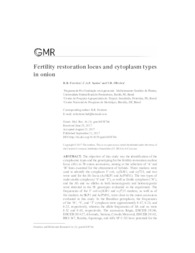Fertility restoration locus and cytoplasm types in onion.
Fertility restoration locus and cytoplasm types in onion.
Autoria: FERREIRA, R. R.; SANTOS, C. A. F.; OLIVEIRA, V. R. de
Resumo: The objective of this study was the identification of the cytoplasmic types and the genotyping for the fertility restoration nuclear locus (Ms) in 59 onion accessions, aiming at the selection of ‘A’ and ‘B’ lines essential for the obtainment of hybrids. Three markers were used to identify the cytoplasm 5’ cob, orfA501, and orf725, and two were used for the Ms locus (AcSKP1 and AcPMS1). The two types of male-sterile cytoplasm (‘S’ and ‘T’), as well as fertile cytoplasm (‘N’), and the Ms and ms alleles in both homozygosity and heterozygosity were detected in the 59 genotypes evaluated in the experiment. The frequencies of the 5’ cob/orfA501 and orf725 markers, as well as of the markers AcSKP1 and AcPMS1, were close in the onion accessions evaluated in this study. In the Brazilian germplasm, the frequencies of the ‘N’, ‘S’, and ‘T’ cytoplasm were approximately 0.47, 0.28, and 0.25, respectively, whereas the allele frequencies of Ms and ms were 0.52 and 0.48, respectively. The accessions Régia, EHCEB 20146, EHCEB 201427, Alvorada, Serrana, Crioula Mercosul, EHCEB 20142, BRS 367, Rainha, Juporanga, and Alfa SF C-XI have potential for theidentification of ‘A’ and ‘B’ lines, since they presented mixtures of cytoplasm and different allele frequencies for Ms. All the plants of the accessions EHCEB 20142040/EHCEB 20141040, EHCEB 20142028/EHCEB 20141028, and EHCEB 20112006/EHCEB 20111006 were in the Nmsms and Smsms conditions, and have the potential for ‘B’ and ‘A’ lines, respectively, for the CMS-S system. All the plants of the accessions EHCEB 20142027/EHCEB 20141027, EHCEB 20102019/ EHCEB 20101019, and Alfa SF ‘B’/Alfa SF ‘A’ were in Nmsms and Tmsms conditions, and have the potential for ‘B’ and ‘A’ lines, respectively, for the CMS-T system.
Ano de publicação: 2017
Tipo de publicação: Artigo de periódico
Unidade: Embrapa Semiárido
Palavras-chave: Allium cepa, Cebola, Citoplasma, Cybrids, Cytoplasm, DNA, Extração genômica, Hybrid, Maintainer lines, Male sterile, Melhoramento genético, Nucleocytoplasmic interaction, Onion, Onions
Observações
1 - Por padrão são exibidas publicações dos últimos 20 anos. Para encontrar publicações mais antigas, configure o filtro ano de publicação, colocando o ano a partir do qual você deseja encontrar publicações. O filtro está na coluna da esquerda na busca acima.
2 - Para ler algumas publicações da Embrapa (apenas as que estão em formato ePub), é necessário ter, no celular ou computador, um desses softwares gratuitos. Sistemas Android: Google Play Livros; IOS: iBooks; Windows e Linux: software Calibre.
Acesse outras publicações
Acesse a Base de Dados da Pesquisa Agropecuária (BDPA) para consultar o acervo completo das bibliotecas da Embrapa.

